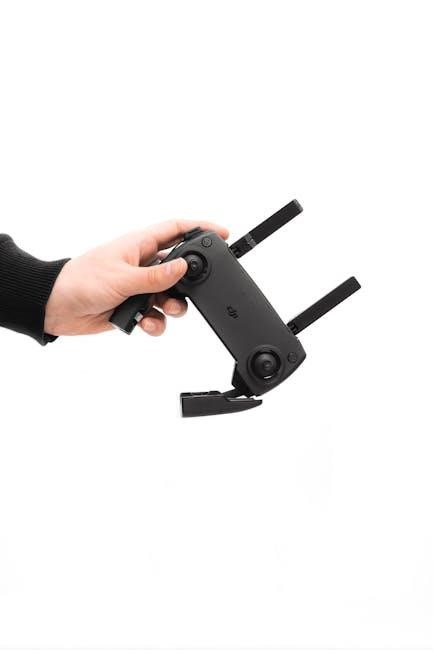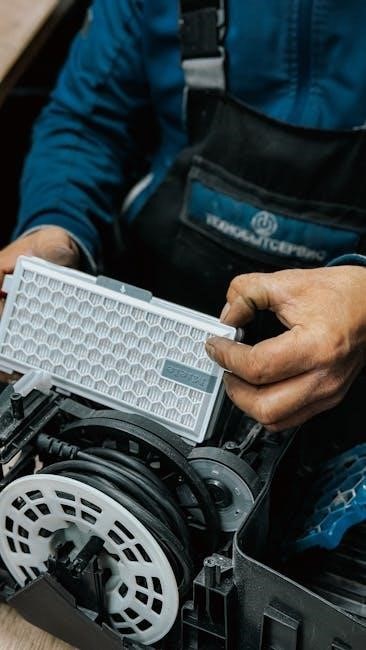The 1734-AENT adapter enables EtherNet/IP communication for POINT I/O modules, supporting efficient integration into industrial control systems with advanced networking capabilities and CIP compatibility.
1.1 Overview of the 1734-AENT Adapter
The 1734-AENT adapter is a POINT I/O EtherNet/IP module designed to enable seamless communication between industrial control systems and I/O devices. It supports the Common Industrial Protocol (CIP) and provides efficient data transfer over EtherNet/IP networks. This adapter is integral for integrating POINT I/O modules into industrial automation systems, offering features like direct connections and rack-optimized configurations. It is compatible with various firmware versions and software tools, ensuring flexibility and scalability. The adapter’s design allows for easy installation on DIN rails and supports advanced networking models, making it a robust solution for modern industrial control applications. Refer to the user manual for detailed setup and configuration guidance.
1.2 Key Features of the Adapter
The 1734-AENT adapter offers several key features that enhance its functionality in industrial automation. It supports both direct and rack-optimized connections, allowing for flexible network configurations. The adapter is compatible with the Common Industrial Protocol (CIP) and utilizes the producer/consumer networking model for efficient data communication. It also features LED status indicators for monitoring system health and supports the Requested Packet Interval (RPI) for optimized data transfer rates. Additionally, the adapter can obtain an IP address automatically via DHCP or BOOTP, simplifying network setup. These features make the 1734-AENT a versatile and reliable component for EtherNet/IP-based control systems, ensuring high performance and ease of integration with POINT I/O modules.

1.3 Importance of the User Manual
The user manual is a critical resource for understanding and effectively using the 1734-AENT adapter. It provides detailed instructions for installation, configuration, and troubleshooting, ensuring safe and proper deployment. The manual covers essential topics such as hardware requirements, network setup, and firmware compatibility, helping users avoid potential issues. It also serves as a reference for advanced features like CIP communication and RPI settings. By following the manual, users can optimize the adapter’s performance and integrate it seamlessly into their EtherNet/IP control systems. Whether for initial setup or ongoing maintenance, the manual is indispensable for maximizing the adapter’s functionality and ensuring operational efficiency.

System Components and Hardware Requirements
The 1734-AENT adapter integrates with POINT I/O modules, including relay and sink output modules, and requires a DIN rail for mounting and a compatible power supply.
2.1 Adapter Features and Specifications
The 1734-AENT adapter is designed for EtherNet/IP communication, supporting CIP and TCP/IP protocols. It features a unique hardware address for network identification and compatibility with various POINT I/O modules. The adapter supports direct and rack-optimized connections, enabling flexible network configurations. It operates with a default IP address setting, allowing DHCP or BOOTP for dynamic IP assignment. The module includes LED status indicators for monitoring and diagnostics. It is mounted on a DIN rail and requires a 24V DC power supply. The adapter’s compact design integrates seamlessly with POINT I/O systems, ensuring efficient communication and control in industrial automation environments.
2.2 Compatible POINT I/O Modules
The 1734-AENT adapter is compatible with a wide range of POINT I/O modules, including digital and analog I/O modules, high-speed counters, and thermocouple/RTD modules. It supports modules such as the 1734-OW2/C relay output module, 1734-OV4E/C sink output module, and very high-speed counter modules. These modules can be easily integrated into the adapter’s backplane, enabling flexible system configuration. The adapter ensures seamless communication and control of I/O modules over an EtherNet/IP network, making it ideal for industrial automation applications. Proper module compatibility is essential for optimal system performance and functionality.
2.3 Network Hardware Requirements
The 1734-AENT adapter requires a 10/100 Mbps Ethernet switch for optimal performance in an EtherNet/IP network. It supports Power over Ethernet (PoE) for simplified installation. The adapter is compatible with standard Ethernet devices and uses TCP/IP and UDP protocols for communication. Ensure the network hardware supports these protocols to maintain reliable data transfer. The adapter also works with ControlLogix controllers and RSLogix 5000 software for seamless integration. Proper network configuration is essential for maximizing the adapter’s performance in industrial automation systems. Always verify hardware compatibility to avoid connectivity issues.
Installation and Configuration
The 1734-AENT adapter is mounted on a DIN rail and wired to the network, requiring configuration for IP settings and EtherNet/IP communication to ensure proper functionality.
3.1 Mounting the Adapter on a DIN Rail
To mount the 1734-AENT adapter, position it vertically above the DIN rail and secure it using the provided mounting hardware. Ensure the adapter is firmly fastened to prevent movement during operation. For new systems, install the adapter before adding I/O modules to avoid complications. If replacing an existing adapter, remove the old one by pulling up on the RTB removal handle, then install the new one following the same alignment. Proper mounting ensures reliable communication and prevents hardware damage. Always cycle power after installation to initialize the system correctly.
3.2 Wiring the Adapter
Proper wiring of the 1734-AENT adapter is essential for reliable operation. Begin by connecting the network cables to the Ethernet ports, ensuring secure connections for data transmission. Next, connect the power supply to the adapter, following the recommended voltage specifications. Wire the I/O modules to the adapter’s backplane, ensuring all terminals are securely fastened. Refer to the adapter’s wiring diagram for specific pin assignments and connections. Always disconnect power before wiring to prevent electrical shock or damage. Use appropriate cable types and verify connections to avoid signal interference. Proper wiring ensures seamless communication between the adapter and connected devices, maintaining optimal performance in your EtherNet/IP control system.
3.3 Configuring the Adapter for Network Communication
To configure the 1734-AENT adapter for network communication, start by setting the IP address. The adapter defaults to obtaining an IP address via DHCP or BOOTP, but you can configure a static IP address if required. Use RSLogix 5000 software to set up the adapter for direct connection or rack-optimized communication. Ensure the adapter is configured to match your network settings, such as subnet mask and gateway. Proper configuration enables seamless communication between the adapter and controllers. Refer to the user manual for detailed steps on configuring network parameters and optimizing settings for your specific application. Correct configuration is critical for reliable performance in your EtherNet/IP control system.
Configuration and Setup
The 1734-AENT adapter requires IP address configuration and setup for direct connections. Use RSLogix 5000 to configure settings and adjust the Requested Packet Interval (RPI) for optimal performance.
4.1 IP Address Configuration
The 1734-AENT adapter can obtain an IP address dynamically via DHCP or BOOTP by default. For static IP configuration, use RSLogix 5000 software to assign a specific IP address, subnet mask, and gateway. Ensure the IP address is unique within the network to avoid conflicts. Static IP setup is recommended for stable communication in industrial control systems. Refer to the user manual for detailed steps on configuring IP settings. Proper IP configuration is critical for enabling EtherNet/IP communication and ensuring seamless integration with POINT I/O modules and controllers. Always verify network settings to maintain optimal performance and avoid connectivity issues.
4.2 Configuring the Adapter for Direct Connection
To configure the 1734-AENT adapter for a direct connection, use RSLogix 5000 software to establish a real-time data transfer link. Set the Requested Packet Interval (RPI) during configuration to define the cyclic rate for data exchange. Direct connections enable efficient communication between the controller and the adapter, bypassing traditional rack optimization. Ensure the adapter’s IP address and network settings align with the controller’s configuration. This setup is ideal for applications requiring low-latency, high-speed data transfer. Proper configuration ensures reliable communication and optimal performance in industrial control systems. Refer to the user manual for detailed steps to configure direct connections and RPI settings effectively.
4.3 Setting Up the Requested Packet Interval (RPI)
The Requested Packet Interval (RPI) determines the cyclic rate of data exchange for direct connections. Configure the RPI in RSLogix 5000 software to optimize communication between the controller and the 1734-AENT adapter. A lower RPI increases data transfer speed but may reduce network efficiency. Set the RPI based on the specific requirements of your application, ensuring it aligns with the controller’s capabilities. Proper RPI configuration ensures reliable and efficient data communication. Refer to the user manual for detailed instructions on configuring the RPI and achieving optimal performance in your EtherNet/IP control system.

Firmware and Software Compatibility
The 1734-AENT adapter is compatible with specific firmware versions and software releases. Ensure compatibility by contacting Rockwell Automation for necessary upgrades to maintain optimal performance and functionality.
5.1 Compatible Firmware Versions
The 1734-AENT adapter requires specific firmware versions to ensure proper functionality. Compatible firmware revisions are detailed in the user manual, ensuring optimal performance with EtherNet/IP networks. The adapter supports direct connections and rack-optimized configurations, requiring firmware updates for certain bridge modules. Contact Rockwell Automation for firmware upgrades to maintain compatibility. The default chassis size is set to 1 slot, and cycling power assigns module addresses. Ensure firmware alignment with your control system for reliable operation. Always refer to the manual for the latest firmware requirements and upgrade instructions to avoid compatibility issues.
5.2 Software Releases and Tools
The 1734-AENT adapter is compatible with specific software releases, including RSLogix 5000 and RSLinx, for configuration and communication. Ensure the latest software tools are installed to maintain optimal performance. Rockwell Automation recommends using compatible versions of these tools to configure the adapter and manage EtherNet/IP networks. The adapter supports direct connections and rack-optimized configurations, which can be set up using RSLogix 5000. Refer to the user manual for detailed instructions on software compatibility and configuration. Proper software setup is essential for reliable operation and troubleshooting. Always verify software versions before installation to avoid compatibility issues.
5.3 Upgrading Firmware and Software

Upgrading the firmware and software for the 1734-AENT adapter is essential for maintaining compatibility and ensuring optimal performance. Always use firmware and software versions approved by Rockwell Automation. Before upgrading, verify the current firmware version and compare it with the latest release available on Rockwell Automation’s website. Use RSLogix 5000 or RSLinx tools to perform the upgrade, following the step-by-step instructions in the user manual. Ensure the adapter is powered on and connected to the network during the upgrade process. Improper upgrades can cause system malfunctions, so adhere to the recommended procedures. Contact Rockwell Automation support if issues arise during the upgrade.

Safety Considerations
Always follow safety guidelines when handling the 1734-AENT adapter. Solid-state equipment requires careful handling to prevent damage. Ensure power is disconnected before installation or maintenance. Use proper grounding and adhere to hazardous location standards if applicable.

6.1 General Safety Guidelines
Always follow safety guidelines when working with the 1734-AENT adapter. Solid-state equipment differs from electromechanical devices, requiring careful handling to prevent damage. Ensure power is disconnected before installation or maintenance. Avoid exposing the module to extreme temperatures or humidity. Use proper grounding and adhere to hazardous location standards if applicable. Refer to the Safety Guidelines for Solid State Controls for detailed precautions. Never operate the adapter in environments beyond its rated specifications. Properly secure all connections to avoid electrical arcs, especially in hazardous locations. Consult Rockwell Automation documentation for compliance with local regulations and standards.
6.2 Installation and Maintenance Precautions
Disconnect power before installing or maintaining the 1734-AENT adapter to ensure safety. Avoid connecting or disconnecting wiring while field-side power is on, as this could cause electrical arcs or explosions in hazardous locations. Mount the adapter vertically on a DIN rail, ensuring it is securely fastened. Use appropriate tools and follow proper grounding procedures. Do not operate the adapter in environments exceeding its rated specifications. Regularly inspect connections and wiring for damage or wear. When replacing the adapter, follow the removal steps carefully to avoid damaging the DIN rail or terminal block. Always refer to the user manual for specific installation and maintenance instructions to ensure safe and reliable operation.
6.3 Hazardous Location Considerations
When installing the 1734-AENT adapter in hazardous locations, adhere to all applicable safety standards and guidelines. Solid-state equipment like the adapter has unique operational characteristics compared to electromechanical devices, requiring special precautions. Ensure proper grounding and follow installation instructions to prevent electrical hazards. Refer to Rockwell Automation’s Safety Guidelines for Solid State Controls for detailed instructions. Use the adapter only in environments where it is rated for operation, and avoid exposing it to conditions beyond its specifications. Regularly inspect the system for wear or damage that could compromise safety in hazardous areas.

Troubleshooting and Maintenance
Use LED status indicators to diagnose issues. Refer to the user manual for common problems and solutions. Perform routine maintenance to ensure optimal performance and reliability.
7.1 LED Status Indicators
The 1734-AENT adapter features LED status indicators that provide critical information about its operational state. The LEDs display colors such as green, amber, and red, each signifying specific conditions. A steady green LED indicates a successful connection and normal operation, while amber may signal a fault or configuration issue. A red LED typically denotes a network problem or power failure. Blinking LEDs can indicate data activity or errors. Refer to the user manual for detailed interpretations of LED patterns, as they are essential for diagnosing and resolving issues. These indicators are invaluable for quick troubleshooting and ensuring the adapter functions optimally in your EtherNet/IP system.
7.2 Common Issues and Solutions
Common issues with the 1734-AENT adapter include power supply problems, network connectivity errors, and configuration mismatches. If the adapter fails to power on, check the power supply connections and ensure the DIN rail is properly secured. For network issues, verify Ethernet cable connections and IP address settings. Resetting the adapter or reconfiguring it in RSLogix 5000 may resolve communication faults. Configuration errors can often be fixed by ensuring firmware compatibility and updating software tools. Refer to the user manual for detailed troubleshooting steps and solutions. Regular maintenance and firmware updates help prevent recurring issues and ensure optimal performance.
7.3 Routine Maintenance Tips
Regular maintenance ensures optimal performance of the 1734-AENT adapter. Power cycle the adapter periodically to reset connections and clear temporary issues. Inspect Ethernet cables for damage or loose connections, and clean the module’s contacts to prevent corrosion. Check for firmware updates and install the latest versions to maintain compatibility and security. Monitor LED status indicators for error codes and address them promptly. Ensure proper ventilation to avoid overheating, and verify DIN rail mounting for stability. Refer to the user manual for detailed maintenance procedures and guidelines. Routine checks help prevent downtime and ensure reliable operation in industrial environments.
Advanced Networking Concepts
The 1734-AENT supports CIP, enabling efficient data exchange, and operates using the Producer/Consumer model for scalable communication. Rack-Optimized connections ensure high-speed data transfer in industrial networks.
8.1 Understanding the Common Industrial Protocol (CIP)
The Common Industrial Protocol (CIP) is a core communication standard enabling efficient data exchange in industrial networks. The 1734-AENT adapter utilizes CIP to facilitate seamless communication between devices, ensuring compatibility and reliability. CIP supports both cyclic and acyclic data transfers, making it versatile for various industrial applications. The protocol operates on EtherNet/IP networks, allowing devices to interact using a standardized set of rules. Key features include device discovery, data encapsulation, and error handling. The adapter’s CIP implementation supports the Producer/Consumer model, enabling scalable and efficient data distribution. Understanding CIP is essential for configuring and optimizing the 1734-AENT adapter in industrial control systems.
8.2 Producer/Consumer Networking Model
The Producer/Consumer model is a networking paradigm supported by the 1734-AENT adapter, enabling efficient data distribution across industrial networks. In this model, devices act as producers by generating and sending data, while others act as consumers by receiving and processing it. This approach replaces the traditional master/slave model, offering greater flexibility and scalability. The adapter allows for precise control over message routing, enabling alternative communication paths for the same device. This model is particularly beneficial in large-scale industrial systems, where real-time data transfer and reduced latency are critical. The 1734-AENT adapter’s implementation of the Producer/Consumer model ensures efficient and reliable communication, optimizing overall system performance.
8.3 Rack-Optimized and Direct Connections
The 1734-AENT adapter supports both rack-optimized and direct connections, offering flexibility in industrial networking. Rack-optimized connections enable communication with multiple modules in a chassis, while direct connections provide real-time data transfer between the controller and a specific module. Direct connections operate cyclically based on the Requested Packet Interval (RPI), ensuring low latency and high efficiency. This dual capability allows the adapter to adapt to various system architectures, optimizing performance for different applications. Rack-optimized connections are ideal for large-scale systems with multiple I/O modules, while direct connections are suited for applications requiring fast, dedicated communication. This versatility enhances the adapter’s suitability for diverse industrial control systems.

Additional Resources and References
Visit Rockwell Automation’s official website for comprehensive support, including user manuals, installation guides, and firmware updates. Engage with online forums for community-driven troubleshooting and insights.
9.1 Rockwell Automation Support and Documentation

Rockwell Automation provides extensive support and documentation for the 1734-AENT adapter, including user manuals, installation guides, and firmware updates. Visit their official website for access to these resources, ensuring optimal setup and operation. The documentation covers safety guidelines, troubleshooting, and detailed configuration steps. Firmware compatibility and software tools are also addressed to maintain system performance. For specific inquiries, refer to publications like 1734-UM011D-EN-P, which offers comprehensive insights. Rockwell Automation’s support team is available for further assistance, ensuring seamless integration of the 1734-AENT into your industrial control system.
9.2 Related Manuals and Guides
Several related manuals and guides are available for the 1734-AENT adapter, including the 1734-UM011D-EN-P User Manual, which provides detailed installation, configuration, and troubleshooting information. Additional resources include the Installation Instructions Manual and guides for specific modules like the POINT I/O Thermocouple and RTD Modules. These documents are essential for understanding advanced features, such as CIP communication and network optimization. Manuals are available in PDF format for easy access and reference. Ensure to consult these guides for comprehensive setup and maintenance of the 1734-AENT adapter, as well as for troubleshooting common issues and optimizing system performance.
9.3 Online Communities and Forums
Online communities and forums provide valuable resources for troubleshooting and optimizing the 1734-AENT adapter. Platforms like ManualsLib and Rockwell Automation forums offer extensive discussions, user experiences, and solutions. These communities are ideal for resolving common issues, understanding advanced configurations, and staying updated on firmware releases. Users can access troubleshooting guides, configuration tips, and best practices shared by experts and peers. Additionally, Rockwell Automation’s official forums provide direct support and updates, ensuring users can leverage the full potential of their 1734-AENT adapter. Engaging with these communities fosters collaboration and helps users overcome challenges efficiently, enhancing their overall experience with the adapter.